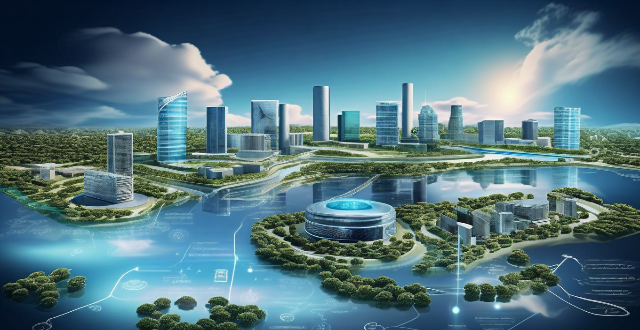The future of climate-smart technology is expected to be transformative, offering numerous ways to mitigate climate change and adapt to its effects. Key areas of development include renewable energy, energy efficiency, carbon capture and storage, water management, and agriculture. Emerging technologies such as artificial intelligence, blockchain, and the Internet of Things also have significant potential in this field. However, challenges such as cost, infrastructure, regulation, and public acceptance must be addressed to ensure widespread adoption and effectiveness.

The Future of Climate-Smart Technology
Climate-smart technology refers to innovative solutions that help mitigate climate change and adapt to its impacts. These technologies are designed to reduce greenhouse gas emissions, improve energy efficiency, and enhance resilience to extreme weather events. As the world faces increasingly severe climate challenges, the future of climate-smart technology is expected to be bright and transformative.
Key Areas of Development
1. Renewable Energy
- Solar Power: Continued advancements in photovoltaic cells and solar storage systems will make solar power more accessible and affordable for households and businesses.
- Wind Energy: Improvements in turbine design and materials will lead to larger, more efficient wind turbines capable of generating significant amounts of clean energy.
- Geothermal Energy: Innovations in drilling and heat exchange technologies will unlock the vast potential of geothermal energy, particularly in regions with high geothermal activity.
2. Energy Efficiency
- Buildings: Smart buildings equipped with automated systems for heating, cooling, and lighting will optimize energy consumption based on occupancy patterns and external conditions.
- Transportation: Electric vehicles (EVs) and hybrid engines will become more prevalent as battery technology improves, reducing reliance on fossil fuels.
- Industry: Energy-efficient manufacturing processes and waste heat recovery systems will minimize energy waste and lower production costs.
3. Carbon Capture and Storage (CCS)
- Direct Air Capture: Techniques for removing CO2 directly from the atmosphere will be refined, potentially offering a means to reverse some of the damage already done by greenhouse gas emissions.
- Enhanced Oil Recovery (EOR): CO2 can be used in EOR, not only storing it underground but also increasing oil production efficiency.
- Bioenergy with Carbon Capture and Storage (BECCS): Combining biomass energy production with CCS could create a negative carbon cycle, where more carbon is stored than released.
4. Water Management
- Desalination: More efficient desalination technologies will provide freshwater sources in arid regions, reducing stress on local water supplies.
- Rainwater Harvesting: Systems for collecting and purifying rainwater will become integral parts of urban planning, conserving water resources.
- Flood Control: Smart flood management systems using sensor networks and real-time data analysis will help prevent flood damage and protect communities.
5. Agriculture
- Precision Farming: Utilizing drones, satellite imagery, and AI algorithms, farmers can optimize crop yield while minimizing resource use and environmental impact.
- Genetic Engineering: Crops genetically modified to thrive in changing climates or resist pests without excessive pesticide use will play a crucial role in food security.
- Aquaculture: Innovative aquaculture practices that reduce environmental footprints and increase seafood production will help meet global demand sustainably.
Emerging Technologies
1. Artificial Intelligence (AI)
- Predictive Modeling: AI models can predict weather patterns, helping prepare for natural disasters and manage resources accordingly.
- Energy Management: AI can optimize energy distribution networks, ensuring efficient delivery of electricity generated from renewable sources.
- Sustainable Production: AI algorithms can guide industrial processes to minimize waste and maximize resource efficiency.
2. Blockchain Technology
- Supply Chain Transparency: Blockchain can track products from source to consumer, ensuring ethical sourcing and sustainable practices throughout the supply chain.
- Renewable Energy Trading: Peer-to-peer trading platforms powered by blockchain could facilitate the buying and selling of renewable energy credits.
- Carbon Credits Marketplace: A blockchain-based system could verify and trade carbon credits, incentivizing companies to reduce their carbon footprint.
3. Internet of Things (IoT)
- Smart Grids: IoT devices can monitor and regulate energy usage within smart grids, preventing blackouts and improving overall grid stability.
- Environmental Monitoring: Networks of IoT sensors can monitor air quality, water levels, and other environmental factors in real-time.
- Resource Efficiency: Connected devices can optimize resource consumption in homes and businesses, such as automatic adjustments to heating and cooling based on occupancy.
Challenges and Considerations
While the future of climate-smart technology looks promising, several challenges must be addressed to ensure its widespread adoption and effectiveness:
- Cost: Many climate-smart solutions are still expensive and may require government subsidies or further technological advancements to become cost-effective.
- Infrastructure: Upgrading existing infrastructure to support new technologies can be a massive undertaking requiring significant investment and time.
- Regulation: Governments need to establish clear policies and regulations that encourage the development and use of climate-smart technologies without stifling innovation.
- Public Acceptance: There may be resistance to certain technologies due to concerns over job displacement, privacy issues, or cultural factors. It's essential to involve the public in discussions about these changes and address their concerns.
In conclusion, the future of climate-smart technology is full of potential, offering numerous ways to mitigate climate change and adapt to its effects. By focusing on key areas such as renewable energy, energy efficiency, carbon capture, water management, and agriculture, we can build a more sustainable future for all. However, overcoming financial, logistical, regulatory, and social barriers will be critical to realizing this vision.